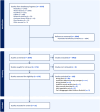Defining and quantifying population-level need for children's palliative care: findings from a rapid scoping review
- PMID: 39174940
- PMCID: PMC11340184
- DOI: 10.1186/s12904-024-01539-8
Defining and quantifying population-level need for children's palliative care: findings from a rapid scoping review
Abstract
Background: The number of children who require palliative care has been estimated to be as high as 21 million globally. Delivering effective children's palliative care (CPC) services requires accurate population-level information on current and future CPC need, but quantifying need is hampered by challenges in defining the population in need, and by limited available data. The objective of this paper is to summarise how population-level CPC need is defined, and quantified, in the literature.
Methods: Scoping review performed in line with Joanna Briggs Institute methodology for scoping reviews and PRISMA-ScR guidelines. Six online databases (CINAHL, Cochrane Library, EMBASE, Medline, PsycINFO, and Web of Science), and grey literature, were searched.
Inclusion criteria: literature published in English; 2008-2023 (Oct); including children aged 0-19 years; focused on defining and/or quantifying population-level need for palliative care.
Results: Three thousand five hundred seventy-eight titles and abstracts initially reviewed, of which, 176 full-text studies were assessed for eligibility. Overall, 51 met the inclusion criteria for this scoping review. No universal agreement identified on how CPC need was defined in population-level policy and planning discussions. In practice, four key definitions of CPC need were found to be commonly applied in quantifying population-level need: (1) ACT/RCPCH (Association for Children with Life-Threatening or Terminal Conditions and their Families, and the Royal College of Paediatrics and Child Health) groups; (2) The 'Directory' of Life-Limiting Conditions; (3) 'List of Life-Limiting Conditions'; and (4) 'Complex Chronic Conditions'. In most cases, variations in data availability drove the methods used to quantify population-level CPC need and only a small proportion of articles incorporated measures of complexity of CPC need.
Conclusion: Overall, greater consistency in how CPC need is defined for policy and planning at a population-level is important, but with sufficient flexibility to allow for regional variations in epidemiology, demographics, and service availability. Improvements in routine data collection of a wide range of care complexity factors could facilitate estimation of population-level CPC need and ensure greater alignment with how need for CPC is defined at the individual-level in the clinical setting.
Keywords: Children; Eligibility criteria; Life-limiting conditions; Life-threatening conditions; Need; Palliative care.
© 2024. The Author(s).
Conflict of interest statement
The authors declare no competing interests.
Similar articles
-
Beyond the black stump: rapid reviews of health research issues affecting regional, rural and remote Australia.Med J Aust. 2020 Dec;213 Suppl 11:S3-S32.e1. doi: 10.5694/mja2.50881. Med J Aust. 2020. PMID: 33314144
-
Children's unmet palliative care needs: a scoping review of parents' perspectives.BMJ Support Palliat Care. 2019 Dec;9(4):439-450. doi: 10.1136/bmjspcare-2018-001705. Epub 2019 Jul 19. BMJ Support Palliat Care. 2019. PMID: 31324615
-
Use of telehealth in the provision of after-hours palliative care services in rural and remote Australia: A scoping review protocol.PLoS One. 2022 Jan 13;17(1):e0261962. doi: 10.1371/journal.pone.0261962. eCollection 2022. PLoS One. 2022. PMID: 35025895 Free PMC article.
-
Healthcare users' experiences of communicating with healthcare professionals about children who have life-limiting conditions: a qualitative systematic review protocol.JBI Database System Rev Implement Rep. 2015 Nov;13(11):33-42. doi: 10.11124/jbisrir-2015-2413. JBI Database System Rev Implement Rep. 2015. PMID: 26657462
-
Defining "early palliative care" for adults diagnosed with a life-limiting illness: a scoping review.BMC Palliat Care. 2025 Apr 4;24(1):93. doi: 10.1186/s12904-025-01712-7. BMC Palliat Care. 2025. PMID: 40186227 Free PMC article.
Cited by
-
Palliative care is an overlooked global health priority.BMJ. 2024 Nov 1;387:q2387. doi: 10.1136/bmj.q2387. BMJ. 2024. PMID: 39486840 Free PMC article.
-
Comparing EQ-5D-5L and IPOS among residents with malignant tumors in a community home hospice: a longitudinal study.BMC Palliat Care. 2025 May 11;24(1):134. doi: 10.1186/s12904-025-01779-2. BMC Palliat Care. 2025. PMID: 40350450 Free PMC article.
-
Adult specialist palliative care services caring for children in the community: a scoping review.BMC Palliat Care. 2025 Jun 23;24(1):167. doi: 10.1186/s12904-025-01792-5. BMC Palliat Care. 2025. PMID: 40551103 Free PMC article.
References
-
- Together for Short Lives. A guide to children’s palliative care. Together for Short Lives: Bristol; 2018.
-
- World Health Organisation. Integrating palliative care and symptom relief into paediatrics: A WHO guide for health care planners, implementers and managers. Geneva: World Health Organization; 2018.
Publication types
MeSH terms
Grants and funding
LinkOut - more resources
Full Text Sources
Medical
Miscellaneous


